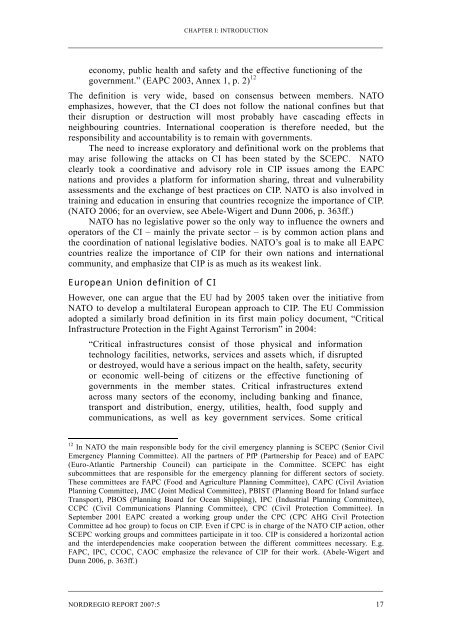Towards a Baltic Sea Region Strategy in Critical ... - Helsinki.fi
Towards a Baltic Sea Region Strategy in Critical ... - Helsinki.fi
Towards a Baltic Sea Region Strategy in Critical ... - Helsinki.fi
You also want an ePaper? Increase the reach of your titles
YUMPU automatically turns print PDFs into web optimized ePapers that Google loves.
CHAPTER I: INTRODUCTION<br />
economy, public health and safety and the effective function<strong>in</strong>g of the<br />
government.” (EAPC 2003, Annex 1, p. 2) 12<br />
The def<strong>in</strong>ition is very wide, based on consensus between members. NATO<br />
emphasizes, however, that the CI does not follow the national conf<strong>in</strong>es but that<br />
their disruption or destruction will most probably have cascad<strong>in</strong>g effects <strong>in</strong><br />
neighbour<strong>in</strong>g countries. International cooperation is therefore needed, but the<br />
responsibility and accountability is to rema<strong>in</strong> with governments.<br />
The need to <strong>in</strong>crease exploratory and def<strong>in</strong>itional work on the problems that<br />
may arise follow<strong>in</strong>g the attacks on CI has been stated by the SCEPC. NATO<br />
clearly took a coord<strong>in</strong>ative and advisory role <strong>in</strong> CIP issues among the EAPC<br />
nations and provides a platform for <strong>in</strong>formation shar<strong>in</strong>g, threat and vulnerability<br />
assessments and the exchange of best practices on CIP. NATO is also <strong>in</strong>volved <strong>in</strong><br />
tra<strong>in</strong><strong>in</strong>g and education <strong>in</strong> ensur<strong>in</strong>g that countries recognize the importance of CIP.<br />
(NATO 2006; for an overview, see Abele-Wigert and Dunn 2006, p. 363ff.)<br />
NATO has no legislative power so the only way to <strong>in</strong>fluence the owners and<br />
operators of the CI – ma<strong>in</strong>ly the private sector – is by common action plans and<br />
the coord<strong>in</strong>ation of national legislative bodies. NATO’s goal is to make all EAPC<br />
countries realize the importance of CIP for their own nations and <strong>in</strong>ternational<br />
community, and emphasize that CIP is as much as its weakest l<strong>in</strong>k.<br />
European Union def<strong>in</strong>ition of CI<br />
However, one can argue that the EU had by 2005 taken over the <strong>in</strong>itiative from<br />
NATO to develop a multilateral European approach to CIP. The EU Commission<br />
adopted a similarly broad def<strong>in</strong>ition <strong>in</strong> its <strong>fi</strong>rst ma<strong>in</strong> policy document, “<strong>Critical</strong><br />
Infrastructure Protection <strong>in</strong> the Fight Aga<strong>in</strong>st Terrorism” <strong>in</strong> 2004:<br />
“<strong>Critical</strong> <strong>in</strong>frastructures consist of those physical and <strong>in</strong>formation<br />
technology facilities, networks, services and assets which, if disrupted<br />
or destroyed, would have a serious impact on the health, safety, security<br />
or economic well-be<strong>in</strong>g of citizens or the effective function<strong>in</strong>g of<br />
governments <strong>in</strong> the member states. <strong>Critical</strong> <strong>in</strong>frastructures extend<br />
across many sectors of the economy, <strong>in</strong>clud<strong>in</strong>g bank<strong>in</strong>g and f<strong>in</strong>ance,<br />
transport and distribution, energy, utilities, health, food supply and<br />
communications, as well as key government services. Some critical<br />
12 In NATO the ma<strong>in</strong> responsible body for the civil emergency plann<strong>in</strong>g is SCEPC (Senior Civil<br />
Emergency Plann<strong>in</strong>g Committee). All the partners of PfP (Partnership for Peace) and of EAPC<br />
(Euro-Atlantic Partnership Council) can participate <strong>in</strong> the Committee. SCEPC has eight<br />
subcommittees that are responsible for the emergency plann<strong>in</strong>g for different sectors of society.<br />
These committees are FAPC (Food and Agriculture Plann<strong>in</strong>g Committee), CAPC (Civil Aviation<br />
Plann<strong>in</strong>g Committee), JMC (Jo<strong>in</strong>t Medical Committee), PBIST (Plann<strong>in</strong>g Board for Inland surface<br />
Transport), PBOS (Plann<strong>in</strong>g Board for Ocean Shipp<strong>in</strong>g), IPC (Industrial Plann<strong>in</strong>g Committee),<br />
CCPC (Civil Communications Plann<strong>in</strong>g Committee), CPC (Civil Protection Committee). In<br />
September 2001 EAPC created a work<strong>in</strong>g group under the CPC (CPC AHG Civil Protection<br />
Committee ad hoc group) to focus on CIP. Even if CPC is <strong>in</strong> charge of the NATO CIP action, other<br />
SCEPC work<strong>in</strong>g groups and committees participate <strong>in</strong> it too. CIP is considered a horizontal action<br />
and the <strong>in</strong>terdependencies make cooperation between the different committees necessary. E.g.<br />
FAPC, IPC, CCOC, CAOC emphasize the relevance of CIP for their work. (Abele-Wigert and<br />
Dunn 2006, p. 363ff.)<br />
NORDREGIO REPORT 2007:5 17

















